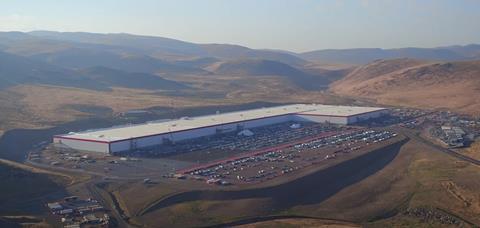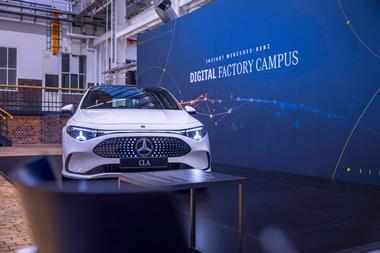At its annual shareholder meeting and battery day event, Tesla revealed a host of production innovations to make lithium-ion battery manufacturing more efficient and reduce costs. Although the premium electric vehicle maker keeps its cards close to its chest when it comes to how exactly it will achieve these innovations, it did announce plans to start its own battery cell production to supplement those provided by suppliers.

Tesla is looking to increase production volumes and to lower the cost of its vehicles, which includes launching a sub-$25,000 car within three years, as EVs still only make up at tiny proportion of the total vehicle fleet worldwide. The company reckons that to convert the whole vehicle fleet to electric would take a battery production capacity of 10TWh/year. Tesla’s current battery factories produce in the range of 15GWh/year, or 0.15TWh, hence why it calls them gigafactories. As a result, the automotive industry will need ‘terafactories’ to produce enough batteries.
As current battery factories aren’t scalable enough to achieve that, the industry needs dramatic improvements in efficiency, both in the factories themselves and in the battery cell production process. Elon Musk said: “If you break down the factory into cubic metre sections and ask if a majority of that volume is doing useful work, you’d be astounded at how bad most factories are, including our factory in Fremont.”
In-house battery cell production
In addition to a number of other battery cell design changes, the most significant change is that Tesla plans to start producing the cells itself. Currently, it sources them from Panasonic, LG Chem and CATL, and assembles them into battery packs at its gigafactories in Nevada, Shanghai and soon, in Berlin. It is aiming for cell production of 100GWh per year by 2022 and 3TWh per year by 2030, although it will still source cells from suppliers as well. Musk said that by using nickel and lithium resources available within North America, and producing the cells in Nevada, it could potentially reduce the miles travelled for the battery production by 80%.
Musk added that consistent free cash flow generation is extremely important for a fast-growing company like Tesla and that a significant component of maintaining free cash flow that is to shorten the supply chain. That includes manufacturing the cells in-house, but Tesla wants to go one step further in its vertical integration and even do some of the lithium mining itself. To that end it has acquired the rights to a lithium-rich clay deposit in Nevada.
Battery improvements
To further optimise manufacturing of the cells (either at its own plants or at suppliers’), Tesla detailed a number of innovations that promise to make the batteries both cheaper and faster to make, as well as more powerful.
The change that would have the biggest impact on the supply chain is to reduce the cobalt content of the cathode and gradually replace it with either iron, a mix of nickel and manganese, or pure nickel, depending on the application. This is certainly not an objective that is exclusive to Tesla, as cobalt often comes from mines in the Democratic Republic of Congo that have questionable ethical standards. However, developing a cell that doesn’t need cobalt is very difficult as cobalt is more stable than nickel.
Tesla now claims to have a solution in the works that will remove cobalt entirely thanks to novel coatings and dopants. It claims it has also refined the cathode production process itself, to simplify it and reduce the waste products. Using these techniques, it plans to start production of the cathodes at a new US cell production factory, which it plans to co-locate with a lithium conversion facility. The exact location of this new plant has yet to be determined.
On the anode side, Tesla also announced a few improvements, using less graphite in favour of more pure silicon, which is cheap and readily available, but comes with the disadvantage that it is prone to expanding and cracking when used in the anode. Tesla doesn’t reveal exactly how it has solved this issue, saying only that it is designing the cells to allow and work with the expansion.
To top off the battery cell changes, Tesla is working on an entirely different architecture. First, it claims to have succeeded in making the individual cells larger, without a drop in efficiency. As such, Tesla is looking to move from so-called 2170 cells (which have a 21mm diameter and a 70mm length) to 4680 cells (46mm diameter, 80mm length). In addition, it wants to launch a tabless architecture, which eliminates the tab that connects the anode to the cathode. This is said to greatly simplify the production process. Tesla is also working on a dry coating process for the electrode that promises to reduce the electrode factory footprint by a factor of ten. Even by Tesla’s own admission, this process is still some way off, however.
Unusual vertical
Daniel Harrison, analyst at Ultima Media, commented: “As our recent battery supply chain presentation at ALSC Live mentioned, the localisation of battery cell plants is a strong clear trend as EV volumes ramp up, but this is much less so for the cathodes, anodes and raw materials. Tesla’s plan for an (almost) complete vertical integration from battery components to finished vehicle is unusual within the automotive industry and is perhaps only matched by BYD in China – an OEM and a cell manufacturer.”
Harrison said the move had major implications for battery supply chains and where the value exists.
“If Tesla’s battery supply chain model proves successful, and it is likely to prevail, will other OEMs follow suit and also start vertically integrating their battery supply chains to recover the loss of value that outsourcing of the battery means in the EV revolution?”
A final important change to Tesla’s production process is that it has changed the way the front and rear body structures for the Model Y are built. Thanks to a new extra-large casting machine and a new aluminium alloy of its own invention, Tesla can now cast the front and rear body sections as a large single-piece casting each, with no need for heat treatment.






































No comments yet